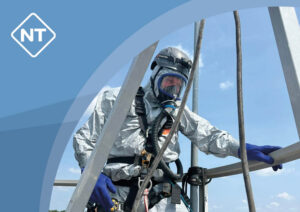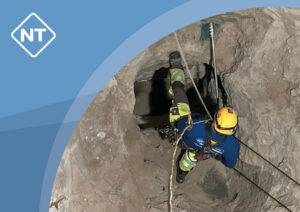“Intelligent blasting” for silo cleaning
A special operation using the electric detonation method. When one hears of blasting operations, many people think of bridge or building collapses, but rarely of the use of explosives in an enclosed space such as a silo. However, when solving a material blockage in a storage silo, targeted blasting can be an effective solution without causing damage to the silo or the environment. The experts at NT Service GmbH have the necessary expertise and technical skills to successfully carry out “intelligent blasting”.
A company in the filter dust disposal sector asked us for assistance with a severe compaction and blockage in their silo. Our aim was to loosen the blockage by means of a loosening blast and remove the compaction so that the material could then be extracted without increasing the pressure in the silo or causing damage to the walls.
Preparation for use
The basis for the use of explosives is a thorough risk assessment carried out by our NT Service team leader and our blasting engineer.
This assessment takes into account the requirements of the DGUV regulations, including the application instructions Spreng TR 310.
Before work can begin, a comprehensive safety concept is drawn up that includes all the important steps, from the inspection of the silo using rope access technology to the necessary safety and rescue measures in the event of an incident.
Image description:
The picture shows a rope access technician in a silo placing a detonator with complete concentration and precision. The man is dressed in black from head to toe and is wearing a helmet with safety goggles, which offers him optimum protection. He is in a narrow, vaulted space and climbs up a rope to place the capsule in the right place.
The focus of the photo is on the technician’s hands, which skillfully and securely fasten the capsule in place. The concentration and precision he displays show that he is an experienced professional who can be trusted.
The complex tangle of stones and dirt surrounding the silo can be seen in the background. There is an oppressive silence in the room, broken only by the soft clicking and clacking of tools.
This image shows us the importance and responsibility that rests on the shoulders of a rope access technician when it comes to safely placing a detonator. It also shows us the professionalism and skills required to carry out this task successfully.
The DGUV Information on the use of explosives TR 310 regulates the requirements for the use of explosives with regard to the safety and protection of people and the environment. These instructions relate to the organization, preparation, execution and monitoring of blasting work.
In summary, “intelligent blasting” offers a safe and effective solution for silo deblocking and blockage removal.
Blast cleaning and silo cleaning involve a variety of techniques to remove firmly encrusted dirt and deposits from tanks, silos, pipelines, boilers and other equipment. Explosives are often used to break up the incrustations. The debris and deposits are then removed manually or using suction technology.
The advantages of this method are efficient cleaning without the need for manual labor. It can also be used in areas that are difficult for people to access. A disadvantage may be the need to temporarily evacuate the area to ensure the blasting is carried out safely. Certain precautions and permits must also be obtained to allow the use of explosives.
Removal of a Silo Blockage with Intelligent Blasting Technology / Blasting Cleaning
Resolving a Silo Blockage through ‘Intelligent Blasting’ as a Special Operation with Electrical Ignition
When hearing about blasting work, many readers think of collapsing bridges or buildings being leveled to the ground within seconds. In connection with resolving a material blockage in a storage silo, only a few would consider the use of explosives. A silo is a closed space, and it is often assumed that blasting inside the silo would lead to an explosion or damage to the entire facility. However, it is indeed possible to remove a material blockage through targeted blasting. How is this done?
Our experts at NT Service GmbH have the knowledge and technical capabilities to carry out successful “intelligent blasting” without damaging the silo or the surrounding environment. Read on to discover how this is possible, and follow the accompanying images for more details.
What was our task?
A company in the filter dust disposal industry reported severe silo compaction and blockages in its operations. We were commissioned to resolve the blockage through loosening blasts and eliminate the silo compaction. Our task was to break down the highly compacted material so that it could be vacuumed out. Of course, the work had to ensure that no increased pressure within the silo or damage to the silo walls occurred.
How did our experts prepare for the operation?
The foundation for the use of explosives is a comprehensive risk assessment. This is conducted by the team leader at NT Service and the blasting expert from our partner company, Blasting Technology Berge. With over 40 years of experience in borehole blasting, this company ensures professional execution. The risk assessment follows the requirements of DGUV regulations, including guidelines such as the Application Instructions for Blasting TR 310 (more on this in the next section).
As with every operation, the next indispensable step is creating a safety concept, which is then documented by the team leader.
The safety concept includes:
- Inspection of the silo facility using rope access technology
- Safe maneuvering within the silo facility by access technicians
- Proper and adequately spaced drilling for the blasting charges
- Timely and orderly evacuation of the silo facility
- Safety and rescue measures for any conceivable incidents during the operation
Only once the comprehensive safety concept has been created, discussed, and documented can the actual work begin.
What is regulated by the DGUV Information Application Instructions for Blasting TR 310?
The German Statutory Accident Insurance (DGUV) issues the Application Instructions for Blasting TR 310, which regulate the proper use of explosives and the associated safety measures. These instructions apply to all activities involving the use of explosives, including the resolution of a silo blockage.






